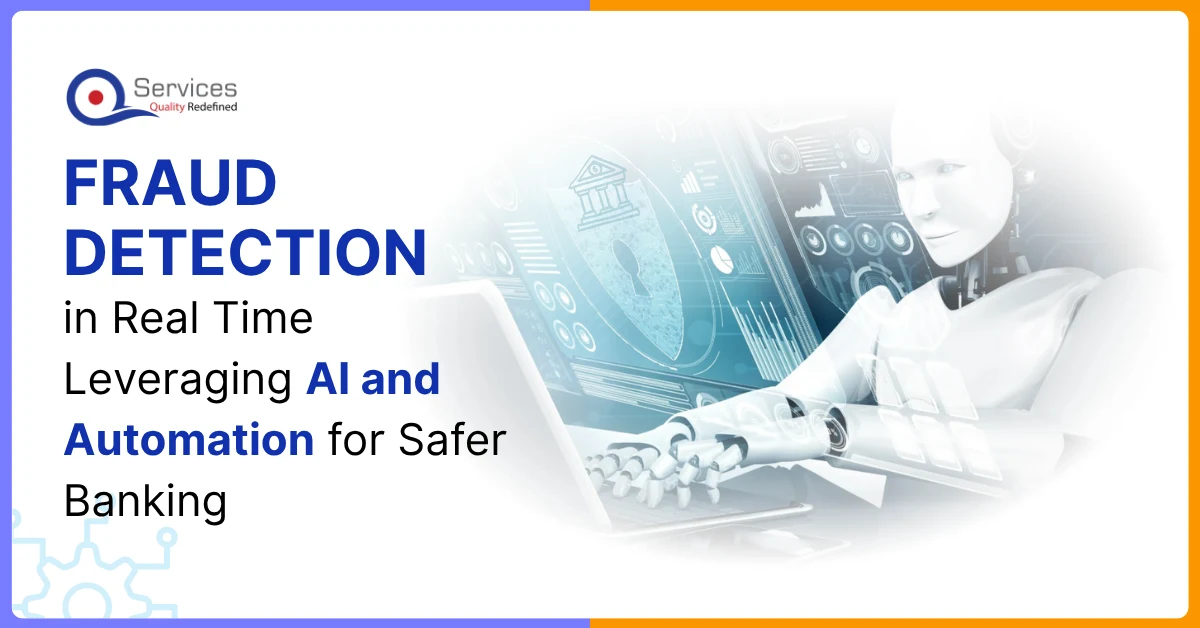
Home » The Future of Banking: AI-Driven Process Automation and Its Impact

Banking, from past few years has undergone major changes with the introduction of automation. Routine tasks like data entry, document processing, and manual approvals have been simplified or eliminated. But the next phase of transformation is even more advanced, powered with AI.
AI-powered process automation moves beyond rule-based tasks. It identifies patterns, learns from data, and makes decisions in real time. In an environment where operations such as fraud detection or credit evaluation seem complex, AI does it with greater speed and precision.
In this blog, we’ll explore how AI-driven automation is reshaping banking. From boosting operational efficiency to improving compliance and risk management, we’ll look at how this technology is creating smarter, more adaptive financial systems.
The future of banking is about meeting evolving demands, means faster service, smarter decisions, and more secure solutions. AI-powered automation is exactly that.
While rule-based systems have already advanced banking with handling repetitive workflows, many contextual tasks still require modern intelligence.
AI-driven automation advances banking by independently making decisions, monitoring risks, and handling other data-heavy tasks with better accuracy and speed than humans. It works like a smart banking assistant that consistently learns and improves.
The more transaction volumes and customer expectations grow, the more AI solutions improve. For making banking future-ready, AI is essential, not optional.
AI-powered automation brings a significant transition to the banking operations that are approached manually. Here are a key areas of transformation:
Fraud detection
AI has moved fraud detection from a reactive process to a proactive one. It continuously analyses millions of transactions and can identify suspicious behaviour and flag anomalies in real time.
Loan underwriting
Traditional credit evaluations rely heavily on FICO scores. AI models go beyond this by incorporating alternative data, such as transaction patterns, geolocation, and even digital behaviour to assess creditworthiness in more detail.
Know Your Customer (KYC) & Anti-Money Laundering (AML)
AI also enhances KYC and AML efforts by automating identity verification and transaction monitoring. Using technologies like Natural Language Processing (NLP) and biometric analysis, it helps banks meet regulatory standards more efficiently.
Customer onboarding
AI significantly shortens onboarding time. With the help of AI chatbots and backend automation, banks can onboard customers 24/7—completing what used to take days in just minutes.
Get free Consultation and let us know your project idea to turn into an amazing digital product.

 Traditional banking automation has its limits, but AI-powered automation is limitless. Banks that implement AI-driven automation gain advantages on both the operational side and the customer side.
Traditional banking automation has its limits, but AI-powered automation is limitless. Banks that implement AI-driven automation gain advantages on both the operational side and the customer side.
 Implementing intelligent automation in banking is as challenging as its rewarding. Banks may have to deal with several issues, including:
Integration with Legacy Systems- Most banks still rely on outdated core systems. Integrating AI technologies with these environments can be complex and costly.
Data Privacy and Governance- AI relies on large datasets that include sensitive customer information. Ensuring compliance and strong data protection is not easy.
High Initial Costs- AI is a high-end solution and demands advanced infrastructure. Even basic implementation can shake budgets, especially for smaller banks.
Change Management- Employee resistance, lack of understanding, and fear of job displacement can also be a challenge.
Implementing intelligent automation in banking is as challenging as its rewarding. Banks may have to deal with several issues, including:
Integration with Legacy Systems- Most banks still rely on outdated core systems. Integrating AI technologies with these environments can be complex and costly.
Data Privacy and Governance- AI relies on large datasets that include sensitive customer information. Ensuring compliance and strong data protection is not easy.
High Initial Costs- AI is a high-end solution and demands advanced infrastructure. Even basic implementation can shake budgets, especially for smaller banks.
Change Management- Employee resistance, lack of understanding, and fear of job displacement can also be a challenge. Share your project idea with us. Together, we’ll transform your vision into an exceptional digital product!

The future of AI in banking is about making smarter use of data and reducing manual tasks, as intelligent technologies will continue to advance. Here are the potential advancements:
Hyper automation
By combining robotic process automation (RPA), AI, and analytics, banks will automate not only individual tasks but entire decision workflows.
Autonomous Banking Systems
Newer systems will increasingly learn and adapt on their own to manage tasks like portfolio rebalancing, fraud detection, and treasury operations.
Generative AI for Strategy and Insights
AI will support more strategic functions by generating reports, summarizing market trends, and providing risk assessments to help guide decision-making.
Embedded AI for Regulatory Reporting
Compliance will become more streamlined with AI automatically creating regulatory reports based on changing rules, directly integrated into banking platforms.
AI-Powered Digital Twins
Banks will use virtual models of their operations to simulate stress scenarios, customer behaviours, and credit risks, enabling better planning before real-world actions.
AI-driven automation itself means intelligence in automation. Banks that once used automation only for repetitive workflows can now perform more complex, contextual, and data-driven tasks with AI solutions.
With AI-powered automation, banks shift from slower, error-prone processes to faster decision-making, improved accuracy, and stronger risk management.
As demands grow, the future of AI in banking lies in enabling smarter and more agile operations that continuously adapt to evolving challenges.
AI in banking refers to artificial intelligence technologies that automate processes, enhance customer service, improve fraud detection, and support decision-making in financial institutions.
AI helps banks handle growing transaction volumes, provide faster services, improve security, and make smarter decisions with data-driven insights.
AI uses machine learning and big data analytics to personalize services, deliver real-time financial insights, and enhance digital customer engagement through predictive analytics.
Initial costs can be high, especially for infrastructure, but long-term savings and efficiency gains often justify the investment.
AI evaluates creditworthiness using alternative data like transaction patterns, digital behaviour, and geolocation, going beyond traditional FICO scores for comprehensive risk assessment.
It’s a virtual model of bank operations used to simulate scenarios like credit risk or fraud to improve decision-making before real events.
Security depends on strong data governance, encryption, and regulatory compliance to protect sensitive customer information during AI processes.
AI automates repetitive tasks but also creates new roles focused on managing, improving, and interpreting AI systems in banking.
Banks face complexity integrating AI with legacy systems, requiring significant investment in infrastructure, staff training, and gradual implementation to ensure seamless technology adoption.

Have a one on one discussion with our Expert Panel

As digital expectations grow, customers now demand speed, ease of use, and 24/7 availability. To meet these demands at scale, digital-only banks choose business process automation in the banking industry to deliver consistent, responsive, and personalized service.

Processing payments involves multiple steps, such as verifying account details, checking records, and ensuring timely execution. In the current financial environment, manual approaches slow down these processes and increase the risk of errors.

Robotic Process Automation (RPA) is no longer limited to large, national banks. Smaller financial institutions like community banks, credit unions, and regional institutions have started implementing this modern automation to find real, practical value.
INDIA : F-190, Phase 8B, Industrial Area, Sector 74,
Mohali, India
CANADA : 55 Village Center Place, Suite 307 Bldg 4287, Mississauga ON L4Z 1V9, Canada
USA :2598 E Sunrise Blvd, Fort Lauderdale,FL 33304,
United States

Founder and CEO

Chief Sales Officer
